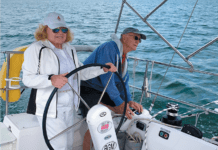Sailing a Dinghy without a Centerboard
Centerboards or daggerboards rarely break (although it is possible to lose a daggerboard during a capsize if is not secured to the boat). However, it is useful to try sailing without one so that you can see just how much they influence the way a dinghy behaves under sail. Stop the boat on a close reach and raise the centerboard completely. Now sail off on a beam reach and watch the way in which the boat slides sideways, making considerable leeway as it sails forward.
Tacking is difficult or impossible without a centerboard to pivot around. Before attempting to tack, get the boat sailing as fast as possible on a close reaching course and push the tiller away farther than usual to try to get the bow through the wind as quickly as possible. If, despite this, the boat fails to tack, you will have to jibe around to change tack.
On upwind courses it is hard to make headway because the dinghy will crab sideways as fast as it goes forward. Experiment with heeling the boat to leeward slightly and moving the crews weight right forward to depress the bow and the Veed sections of the front part of the hull. If you sail a deep-hulled, general-purpose type dinghy, especially one constructed with flat panels and chines, the shape of the hull may provide sufficient lateral resistance to allow you to make some progress to windward. If you sail a dinghy with a very shallow hull, however, it is likely to be impossible to make any progress upwind. Even on a beam reach, the boat will make considerable leeway. It is only when you are on downwind courses, when the centerboard would usually be only slightly down, that the boat will sail normally.
Steve Sleights The Complete Sailing Manual, covers every aspect of sailing and seamanship, whatever your level of experience. Full of hundreds of pages of tips and advice like the information above, The Complete Sailing Manual is sure to help every sailor. Purchase it at Practical Sailor.





































